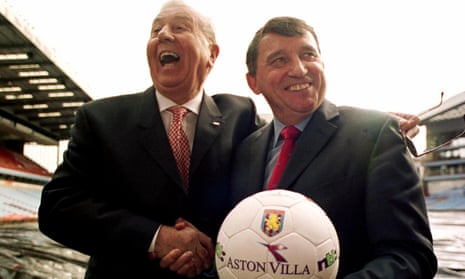It was never exactly a secret that the man known as Deadly Doug was not all that deadly, just an old-fashioned self-made millionaire and club owner who set very high standards for his beloved Aston Villa.
Sir Doug Ellis had two spells as the chairman of Aston Villa, the second and longest running from 1982 to 2006 being the time he became synonymous with the club. He originally took over as the chairman and major shareholder in 1968, after making his fortune in the travel industry, but was forced off the board in 1979, meaning that in the three-year hiatus between terms he managed to miss Villa winning their only post-war title, under Ron Saunders in 1981, and going on to lift the European Cup the following year with victory over Bayern Munich in Rotterdam.
If Ellis was disappointed at not being closely associated with the club’s most successful modern period, an all-too-brief interruption to Liverpool’s dominance at home and abroad, he never let it show.
Despite a relatively humble upbringing in Cheshire, where as a schoolboy he was once on the books at Tranmere Rovers, Ellis always strove to be polite in his dealings and prided himself on the spruce appearance and mannered conversation of the perfect gentlemen. Modest he was not, and many times during his long stewardship he was accused of being more interested in his own profile than that of the club, though even detractors who thought he was on an ego trip would have to admit he was devoted to Villa and definitely in it for the long haul rather than short‑term publicity.
Villa’s status as a big club, in fact, one even now regarded as too solid a concern to reside long in the Championship, can be attributed to the continuity and sense of permanence fostered under Ellis’s control. Nottingham Forest also won the league and the European Cup as the 1970s gave way to the 1980s but a visit to the City Ground now makes one wonder how such a thing was ever possible. Villa Park, on the other hand, remains a handsome and imposing edifice, largely because of the expensive reconstruction Ellis oversaw.
Having reached millionaire status by the age of 40, by exploiting the huge new demand for package holidays to Spain, Ellis never lost the knack for making money, taking advantage of a relaxation in FA rules to begin paying himself a substantial salary in the 1980s and making an estimated £4m from a share flotation a decade later. Villa were relegated in 1987, five years after winning the European Cup and early in Ellis’s second period in charge, but with Graham Taylor in charge they were back at the first time of asking.
Not all of Ellis’s managerial appointments were as successful as Taylor – Billy McNeill was short-lived, Jozef Venglos puzzling and David O’Leary unpopular – but the club had its share of happy times under Ron Atkinson, Brian Little and Martin O’Neill. The last was Ellis’s final managerial appointment and the 12th, meaning that at that point in 2006 he had been personally responsible for hiring half of the managers in Villa’s 122-year history.
Ellis began to relinquish control of the club in his 80s when suffering health problems and, after coming to the conclusion that a major injection of funds would be needed to keep up with the Premier League’s rapidly changing financial landscape, he sold Villa to the American billionaire Randy Lerner in 2006 for an estimated £63m.
What subsequently happened was a painful reminder to supporters that a perceived lack of ambition is not necessarily the worst fault in an otherwise stable football club. Villa failed to thrive under new ownership, eventually going through managers at a quicker rate than Deadly Doug ever did before being relegated in 2016, and remain in the Championship having changed owners twice more in the last couple of years.
Ellis was at Wembley this year to see Villa lose against Fulham in the play-off final. He described the club’s latest relegation as the saddest day of his life and pointed out that after 35 years of “working his guts out” for Aston Villa, he had handed over the club with a good team on the pitch and not a penny of debt.
